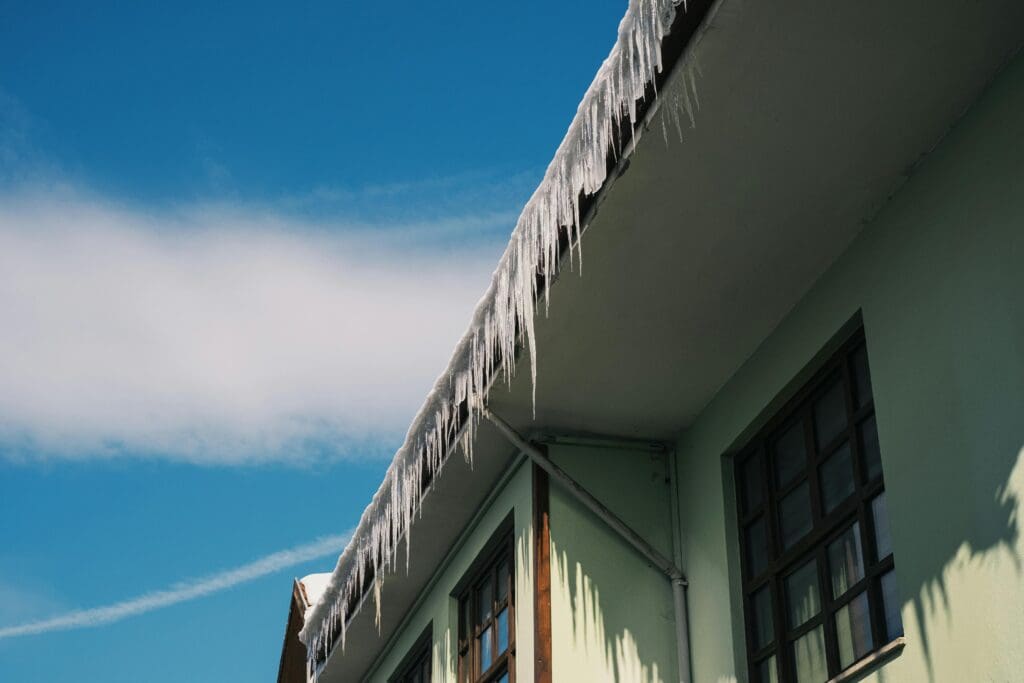Don't Let Winter Turn Your Roof into a Waterfall: How Snow and Ice Can Cause Roof Damage
When people think about roof damage, most people think about the violent hailstorms the Rapid City region experiences annually. Yet, winter’s beauty in the Black Hills can be deceiving. While the glistening blanket of snow creates a picturesque scene, it can wreak havoc on your home’s roof. Snow and ice, though seemingly harmless, pose significant threats to the integrity and functionality of your home’s roof. Let’s examine some of the ways snow and ice can cause damage to your home’s roof.

Heavy Weight of Snow Puts Stress on Your Roof
Fresh snow might appear light and fluffy, but it packs a punch. As it accumulates, the weight can become immense, especially when packed down by wind or freezing temperatures. This burden can cause:
- Structural Damage: Excessive snow load can stress your roof’s trusses, rafters, and decking, leading to cracks, bends, and even complete collapse in extreme cases.
- Shingle Dislodgment: The heavy weight can pull up or loosen shingles, compromising the roof’s waterproofing and exposing the underlayment to the elements.
- Gutter Strain: Gutters overflowing with snow and ice can become overloaded and detach from the roof, potentially causing damage to siding and landscaping.
The Menace of Ice Dams
Melting snow that refreezes at the eaves forms ice dams, destructive barriers that prevent proper water drainage. This trapped water can cause:
- Water Leaks Under Shingles: Backed-up water seeps beneath the shingles, infiltrating the roof’s underlayment and causing interior leaks and water damage.
- Rot and Mold: Trapped moisture fosters the growth of mold and mildew, compromising the structural integrity of the roof and posing health hazards.
- Ice Dam Breaks: As the ice dam builds and weakens, it can break off and fall, damaging gutters, siding, and anything unfortunate enough to be in its path.
Signs Your Roof is Under Winter Siege
Early detection is crucial to preventing major damage. Keep an eye out for these warning signs:
- Sagging Roof Lines: Drooping sections of the roof indicate potential structural compromise.
- Missing or Damaged Shingles: Exposed underlayment or bald patches are red flags.
- Cracked or Peeling Shingles: Deterioration of the shingle surface suggests underlying issues.
- Water Stains, “Bubbling” on Ceilings or Walls: These are clear signs of water infiltration into your home.
- Icicles Hanging from the Eaves: Large icicles, especially near the roof edge, indicate ice dam formation.
Building a Winter-Worthy Roof
When choosing roofing materials, it is essential that you use specifically designed materials to handle the weight, moisture, and freeze/thaw cycles of winter:
- Quality Underlayment: Quality underlayment that offers self-sealing protection for vulnerable areas of the roof against ice and water.
- Metal Flashing: It is essential that high-quality metal flashing is installed where roof lines meet corners, walls, and eaves.
- Strong Roofing Shingles: Choose quality roofing shingles that are rated to stand the test of time.
Remedies for a Roof Damaged by Winter
If your roof has already suffered winter’s wrath, don’t despair. Here are some options:
- Snow Removal: Carefully remove excess snow, but avoid walking directly on the roof. Hiring professionals is often the safest option.
- Ice Dam Removal: Address ice dams cautiously. Use specialized tools or steamers to melt the ice from below, never from the top.
- Shingle Repair or Replacement: Damaged or missing shingles need immediate attention to prevent further water infiltration.
- Professional Roof Inspection: A thorough inspection by a qualified roofer can assess the extent of the damage and recommend the best course of action.
- Regularly check your attic for signs of moisture or leaks, especially after heavy snowfalls.
Winterproofing Your Roof
By understanding the threats posed by snow and ice, choosing the right roofing materials, and taking proactive measures, you can safeguard your roof from winter’s worst. Remember, a healthy roof is a happy home, so don’t let the season of snowflakes turn into a season of roof leaks!
By following these tips, you can ensure your roof weathers the winter storms with grace and keeps your home safe and dry. If you have questions about your home’s roof or roof damage from a recent snow storm, contact the experts at Rypkema Renovations today!



